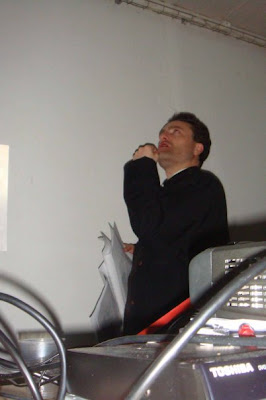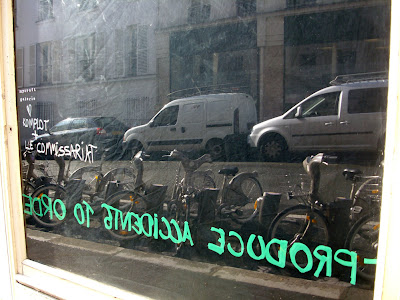By Accident Booklet Cover page
Douglas Park with Matthew Burbidge, David Evrard, Jean-Philippe Convert, David Garchey
Curated by Komplot : http://www.kmplt.be/
14th March - 4th April 2009 /
Opening 14th of March 7pm with performances /
Exhibition from 3 to 8pm, from Wednesday to Saturday and by appointment
le commissariat, 13 rue Ternaux. 75011 Paris.
"We cannot produce accidents to order" (William Burroughs and Brion Gysin, 'The Third Mind', 1978).
‘By Accident', historical survey, “Concept, text & performance” by Douglas Park (with other input from Matthew Burbidge, Jean-Philippe Convert, David Evrard & David Garchey), presented by Komplot, Le Commissariat, Paris, 2009
Image Copyright: Komplot, 2009
Image Copyright: Komplot, 2009
Video by
Matthew Burbidge
Booklet
illustrations by David Evrard
Performance
and translation to French by Jean-Philippe Convert and Komplot
Booklet
design by David Garchey
A project
co-curated by Damien Airault and Komplot for Le Commissariat, Paris 2009
Performance of Jean-Philippe Convert and Douglas Park after a text of Douglas Park
The following attempts to introduce, describe and explain every exponent and example coming to mind and recommended of a seemingly overlooked but nonetheless worthy idiom or genre identified. This cultural area being fate striking work at any stage of production, exposure or whenever, only for drastically affected outcome to be kept by the authors, deliberately addressed and appearing as part of their output –as well as actually generating other work. Existing, original, intentional and self-conscious meaning, expectations and plans can change beyond recognition, actually become further added to –or even lead to entirely new possibilities opening up.
Questions asked encourage and provoke playing with and defiance of proscribed constructs as to whether any process, product, experience or situation is ever predictable, fixed, definitive or controlled in ongoing and inconclusive reality –and also the feasibility of choice and freedom within any conditions.
Such circumstances include (both foreseeable and unexpected): accidents, complications and mistakes; personal setbacks; interpersonal, political, legal, media and public etc adversity and backlash; grievances and disputes; resource and facility shortages; technical hitches; conservation, storage and transit issues; side effects, spinoffs, unfinished business and afterlife; changes of mind; hindsight, improvements, updates, amendments and retraced steps later etc. Still more factors are flexibility, opportunism and capitalisation.
Without detracting from anything, consideration, definition and selection policy struggled with overlap and similarity with other (equally relevant) tendencies and instances not brought about or operating in the same way. These include: useage of other’s work; “challenges” (attempting to influence other’s decisions); works engaged with important and serious episodes, phases and circumstances in the artist’s own life; the reappearance of imagery from and of other works; retrospectives, surveys and monographs as work; archival and preparatory / working material as work; involvement of other’s input in production; solicited and curated contributions submitted to works and projects akin to collections, archives, publications, programs and exhibitions.
Further addressed is explosion of clichés and constructs expecting specialness and supremacy to cultural practice, lifestyle and products –against the inescapable reality of external determining factors occupied; nothing is immune or exempt to social, political, cultural and economic forces or scientific and natural laws. Much that’s included becomes real-life satire on the irrationality and superstition of anecdote, biography, legend, mythology and romanticism (most notably: Wassily Kandinsky’s famous “revelation” about the light filtering through tree leaves and branches, passing on further through his window onto some blank canvas or unfinished work-in-progress –supposedly the “inspiration” behind Kandinsky and other’s early abstraction). Between the critical and creative approach, crossover arises with idea that great scientific and technological discovery and invention come out of mistakes or carelessness.
While belonging more to the (ho, ho, ho) homage (of visual and lingual puns on attributes of major figures and works etc), certain artists and work falling outside this category deserve a mention for addressing issues at stake.
During the rise of the conceptual-era, the Belgian autodidact satirist and social commentator, Jacques Charlier identified ideological and ethical contradictory flaws and downright hypocrisy behind-the-scenes of these supposed radicals and manqué revolutionaries. As well as other works parodying his contemporaries, Charlier photographed workmen struggling with the strain of carrying Daniel Buren’s rolls of striped wallpaper and textiles, Andre Cadere’s clashes and arguments with ordinary gallery and museum personnel about if or where he could place his “barre de bois-ronde”, also capturing the visitors and behaviour at vernissages and other occasions. Additionally, Charlier drew deadpan cartoons and comic strips, including visual and written impressions of what each major male artist’s penis might look like, specific attacks on Buren and Cadere in particular –and even observing the procedures and speakers at a conference. Around the same time, the U.K artist Tony Rickaby, as part of his concerns with class values, wrote and published his bookwork, An Unknown Art History (Art Net, London 1975) and Six Unknown Yet Influential Artists of the 1960’s in General Schmuck periodical (edited by Felipe Ehrenberg and David Mayor, Cullompton, 1975). Both of which are series of short fictional stories about well-known 20th century modern “master” artists crossing paths with some ordinary member of the public during everyday life –with coincidental similarity to their work. More recently, the U.K contemporary artist, musician and educator, Bob & Roberta Smith produces his signboards telling stories which mix and match the people and events of art and cultural history.
© Douglas Park, 2009
FRAGMENTS from an INTRO by Douglas Park (© 2009)
“... Nothing is immune or exempt to social, political, cultural and economic forces or scientific and natural laws. Much that’s included becomes real-life satire on the irrationality and superstition of anecdote, biography, legend, mythology and romanticism...”
“Between the critical and creative approach, crossover arises with idea that great scientific and technological discovery and invention come out of mistakes or carelessness. “
“... Fate striking work at any stage of production, exposure or whenever, only for drastically affected outcome to be kept by the authors, deliberately addressed and appearing as part of their output –as well as actually generating other work... such circumstances include (both foreseeable and unexpected): accidents, complications and mistakes; personal setbacks; interpersonal, political, legal, media and public etc adversity and backlash; grievances and disputes; resource and facility shortages; technical hitches; conservation, storage and transit issues; side effects, spinoffs, unfinished business and afterlife; changes of mind; hindsight, improvements, updates, amendments and retraced steps later...”
Photos by : Kurt Ryslavy, Komplot
samedi 14 mars 2009, par
Douglas Park avec Matthew Burbidge
David Evrard
Jean-Philippe Convert
David Garchey
David Evrard
Jean-Philippe Convert
David Garchey
Vernissage le 14 mars à 19h avec performance
14 mars – 4 avril 2009
Ouvert de 15 à 20h, du mercredi au samedi
Ouvert de 15 à 20h, du mercredi au samedi
L’artiste anglais Douglas Park dégage un flot continu de paroles, tel une encyclopédie de l’art contemporain. En novembre dernier, il a envoyé à ses amis une liste de descriptions de pièces, lesquelles résultent d’accidents dont les artistes ont tiré profit. Cette liste cite aussi bien des artistes proches de Douglas à Londres (Artists Anonymous, Richard Crow, Coum Transmissions,...) que de créateurs plus historiques comme Rasheed Araeen, Joseph Beuys, Daniel Buren, Andre Cadere, Gilbert & George, Susan Hiller, Anne & Patrick Poirier… Au total, une soixantaine de pièces. Le texte est comme une histoire expérimentale de l’art pointant des événements qui relevent de l’accident de travail et ont été décisifs dans le parcours d’un artiste ou le parcours d’une œuvre.
Excités par ce défi, nous nous sommes demandés ce que nous pourrions faire de ce catalogue imaginaire. Alors Matthew Burbidge a filmé une soirée pendant laquelle Douglas monologue dans un pub, délirant et précis, dans les méandres de sa mémoire. David Garchey a mis en page le texte que David Evrard a illustré d’images qui n’ont pas de lien direct avec celui-ci, proposant une équivalence aux objets trouvés. Avec Komplot et Le Commissariat, Jean-Philippe Convert sera l’interprète francophone de Douglas.
http://www.lecommissariat.fr/spip.php?article21
video by Matthew Burbidge
http://vimeo.com/66388571?email_id=Y2xpcF90cmFuc2NvZGVkfDdlMzU0YjE3MDFjMjFhNmM2MmE1NDYxMTQ1Y2U2MjUzNTg1fDE5NjUxNDR8MTM2ODgyNjQ4Mw==&utm_campaign=7701&utm_medium=clip-transcode_complete-finished-20120100&utm_source=email
video by Matthew Burbidge
http://vimeo.com/66388571?email_id=Y2xpcF90cmFuc2NvZGVkfDdlMzU0YjE3MDFjMjFhNmM2MmE1NDYxMTQ1Y2U2MjUzNTg1fDE5NjUxNDR8MTM2ODgyNjQ4Mw==&utm_campaign=7701&utm_medium=clip-transcode_complete-finished-20120100&utm_source=email




















No comments:
Post a Comment